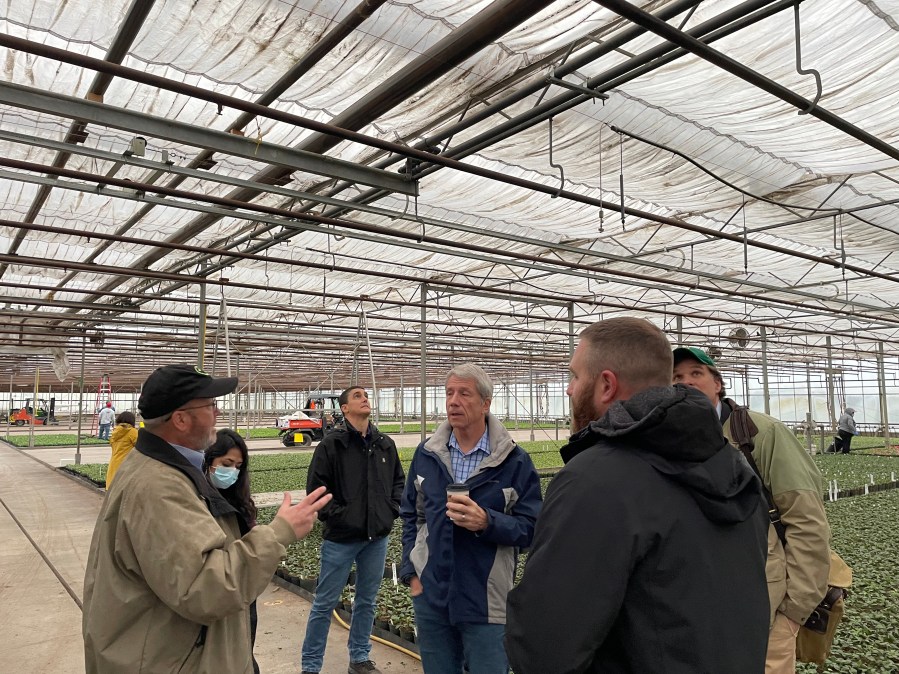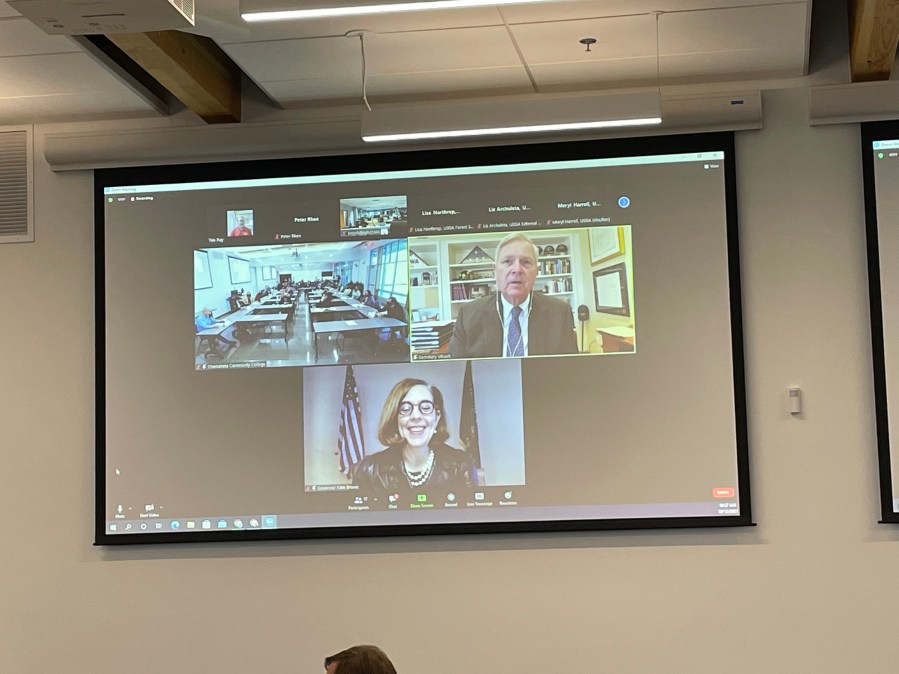PORTLAND, Ore. (KOIN) – Oregon farmers say they need more money from the federal government to cover the losses and damage caused by drought and climate change in the past year.
Several farming and agricultural organizations had the opportunity to share these requests with U.S. Department of Agriculture Undersecretary for Farm Production Robert Bonnie on Monday. He joined U.S. Rep. Kurt Schrader, D-Ore., for two roundtable discussions, one in Woodburn and the other in Salem.
At the event in Woodburn, Schrader toured Woodburn Nursery & Azaleas before he and Bonnie sat down to field questions from concerned farmers
“We are looking to do a better job of delivering our resources where it’s needed,” Bonnie said at the roundtable. “We want to be as helpful as we can and look for ways that we can use the programs we have to deliver the resources folks need.”

The conversation provided an opportunity for farmers to share a variety of things they’re concerned about.
Jeff Stone, executive director of Oregon Association of Nurseries, explained how the funding that is available for disaster relief sometimes does not apply to specialty crops. He said sometimes just because a plant survives a heat event or natural disaster, doesn’t mean a nursery can sell it. It might have damage that makes it unmarketable.
Tammy Denne, the executive director of the Oregon Cattlemen’s Association, said Oregon cattle ranchers suffered greatly during the summer when grasshoppers decimated hay fields. She also said without adequate funding, ranchers are struggling to repair fences that were damaged in wildfires.
A representative for berry farmers in the state said he’d like more funding available for researchers at Oregon State University to develop crops that are more resilient to the hotter temperatures the state has been experiencing.
Ryan Flaherty, growers relations manager of Hazelnut Growers of Oregon, explained how hazelnut growers in Oregon were not getting insurance to cover their yield losses after the February ice storm. The Tree Assistance Program covers losses when farmers lose 18% of their trees, but many hazelnut trees didn’t die completely, they just lost limbs.
With such a wide variety of requests, KOIN 6 News asked Schrader how he can keep track of them all and begin to find ways to address them.
“I’m very tuned in to what Oregon agriculture sees and feels,” said Schrader, who owns a farm in Canby. “It’s pretty easy for me, actually to relate to what’s going on… I will say Congress has been more flexible than I’ve seen for a lot of years and, you know, with the pandemic and associated losses with climate change, we’re trying to be as flexible as possible.”
He also said Congress is in the early stages of starting a new farm bill, but the bill could be 2 to 3 years away. Still, he said all the input he receives from farmers will help draft the future legislation.
After the roundtable in Woodburn, Schrader and Bonnie moved on to Chemeketa Community College in Salem where they held another roundtable to discuss wildfires. They were joined virtually by U.S. Secretary of Agriculture Tom Vilsack and Oregon Gov. Kate Brown.
Vilsack explained that with labor shortages in several fields across the country, there is concern about hiring firefighters for the 2022 wildfire season. He said the infrastructure bill allocates funding to provide better wages for wildland firefighters and he hopes that will help ensure there will be people doing the job.
“These people risk their lives every single year to protect our lives and our property, but we weren’t paying them according to the risk and we certainly weren’t paying them according to the professionalism and experience level and training that they bring to this job,” he said.

Brown took the opportunity to explain what Senate Bill 762 will do to help Oregon prevent and fight fires.
She said the bill provides a roadmap for advancing fire protection in Oregon. It focuses on three main components: creating wildfire adaptive communities, increasing wildfire response, and making landscapes throughout Oregon more resilient to fire.
Someone from the International Association of Machinist & Aerospace Workers union, which represents timber and lumber workers, asked if there was any hope of creating a prevailing wage or better incentives for returning wildland firefighters.
Vilsack said he doesn’t know if that topic has been discussed yet in the Biden administration and planned to speak to the U.S. Forest service about it. In the meantime, he said he believes there’s an opportunity to create a career pathway at the state or federal level to ensure people can work a lifelong career in wildland firefighting, without being constantly laid off and unemployed in the off-season.
Lauren Smith from Oregon Farm Bureau said she’d like communities impacted by human-caused wildfires to have access to the $10 billion the USDA made available for agricultural producers impacted by drought, smoke and heat. Vilsack agreed and said it seems anyone impacted by wildfire, no matter the cause, should have access to those disaster funds.
At the end of the event, Bonnie said the federal government needs to make sure USDA programs are working for people in Oregon.
“It’s good for us, frankly, to get out in the field, meet with producers and figure out what’s working and what’s not so we can do a better job, and that was what was great about today,” he said.
Bonnie again said he hopes the infrastructure bill will help fill some of the gaps Oregon farmers and wildfire agencies are experiencing.